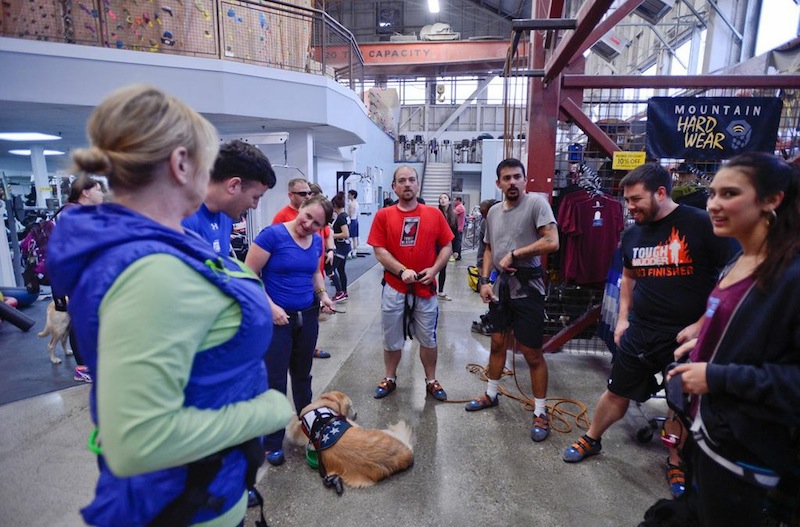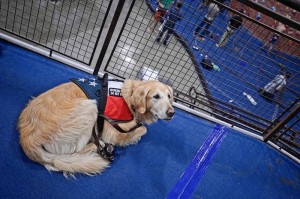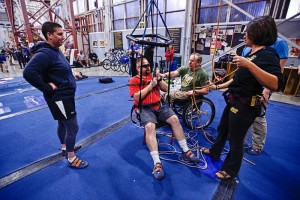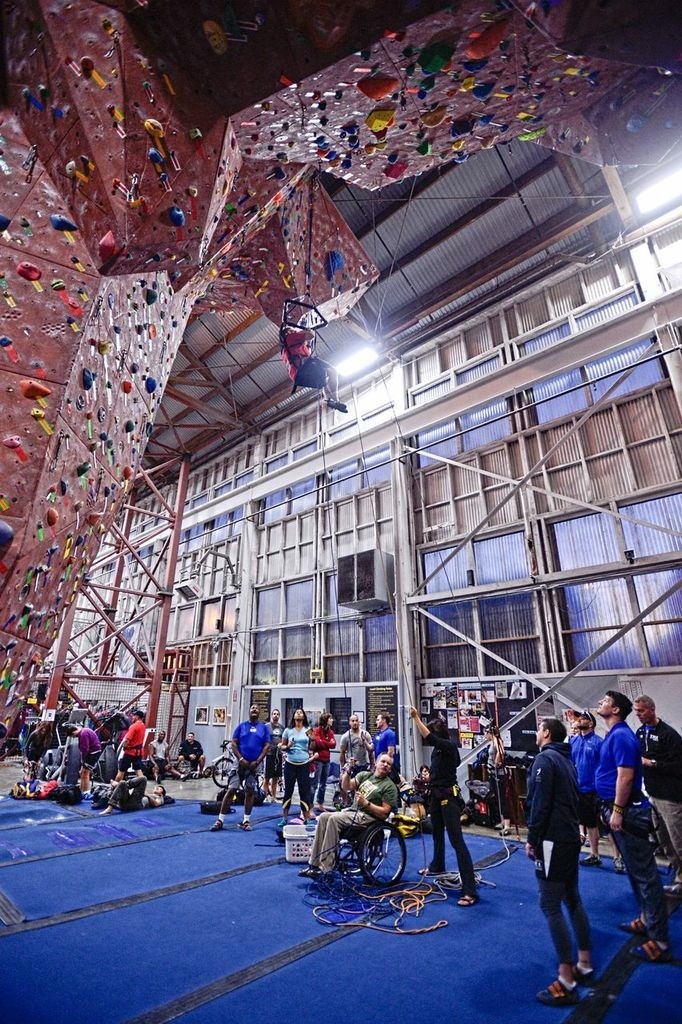It was late on a Saturday afternoon when the bus pulled up outside of Mission Cliffs. The sun had already gone down, and only a few dedicated climbers were still pressing on, trying their hardest to get just one move further on routes they’d been projecting all day. The doors to the gym opened, and the group from the Wounded Warrior Project came through.

The event had been organized months before in a flurry of emails and phone calls, but no one was quite sure just what to expect as the Warriors filled the gym. There was laughing and shouting, everyone staring up at the Main Wall, and the light clacking of paws on polished floors as several service dogs dutifully trailed their owners.
 “Who’s this?” one of the belay staff asked, pointing to a service dog that had nosed its way behind the front desk as the group was outfitted with harnesses and climbing shoes. “That’s Lucy,” a young man answered. At the sound of his voice, Lucy, a skittish German Shepherd, sat up at attention. “We were in Afghanistan together,” he went on, and explained that Lucy was a bomb-sniffing, parachuting dog from a military K-9 unit.
“Who’s this?” one of the belay staff asked, pointing to a service dog that had nosed its way behind the front desk as the group was outfitted with harnesses and climbing shoes. “That’s Lucy,” a young man answered. At the sound of his voice, Lucy, a skittish German Shepherd, sat up at attention. “We were in Afghanistan together,” he went on, and explained that Lucy was a bomb-sniffing, parachuting dog from a military K-9 unit.
“You mean she jumps out of planes?”
“Yup, with her parachute on. She’s seen it all.”
Lucy whimpered and circled her owner.
The Wounded Warrior Project (WWP) was founded in 2003, in the wake of 9/11, to provide support and empowerment for wounded service members returning home from Iraq and Afghanistan. The organization, which was originally based in Virginia, is now a nationwide network that works to raise awareness and help injured veterans heal and recover. Through specific WWP programs, tens of thousands of wounded service members and their families and caregivers receive the support needed to transition back to civilian life.
 These Warriors had come to California from all over the country as part of a week-long program filled with various physical challenges. “We’ve been working out,” said one of the veterans, laughing and flexing his bicep. Their visit to Mission Cliffs was one of the last stops on their trip, and was particularly exciting because WWP had arranged for a special guest to meet with the Warriors and help facilitate the event: Mark Wellman, two- time Paralympian and former Yosemite Park Ranger.
These Warriors had come to California from all over the country as part of a week-long program filled with various physical challenges. “We’ve been working out,” said one of the veterans, laughing and flexing his bicep. Their visit to Mission Cliffs was one of the last stops on their trip, and was particularly exciting because WWP had arranged for a special guest to meet with the Warriors and help facilitate the event: Mark Wellman, two- time Paralympian and former Yosemite Park Ranger.
While everyone was still clustered by the front desk, Mark Wellman had grabbed desk- staffer, Shawn, and the two of them had got to work rigging up an adaptive climbing pulley in the gym, next to the Harrison Street Arch.
Wellman, who lives in Northern California, is an accomplished mountaineer who has ascended over 50 Sierra Nevada peaks. What he is best known for, however, are his ascents in Yosemite. In 1989, just a few years after an accident left him paralyzed from the waist down, Wellman made the historic first paraplegic ascent of the 3,000-foot granite face of El Capitan. Two years later, he went back and snagged the first paraplegic ascent of Half Dome.
 The Warriors divided up into groups, with some of them heading straight to the walls with the Mission Cliffs belay staff, eager to try out top rope climbing. Another group clustered around Wellman as he explained and then demonstrated his adaptive climbing set up. Using an adaptive pull-up bar and ascender, Wellman showed the group how to pull themselves up the ropes to reach the anchors.
The Warriors divided up into groups, with some of them heading straight to the walls with the Mission Cliffs belay staff, eager to try out top rope climbing. Another group clustered around Wellman as he explained and then demonstrated his adaptive climbing set up. Using an adaptive pull-up bar and ascender, Wellman showed the group how to pull themselves up the ropes to reach the anchors.
One of the Warriors volunteered to go next. “This is harder than it looks!” he shouted down from the halfway point. When he got to the top, everyone cheered. A crowd started to gather on the ground around the adaptive pulley. Other climbers in the gym, curious about what was going on, had come over to watch and support the Wounded Warriors on their first ascents at Mission Cliffs.
Over the next hour, veterans who had never envisioned themselves in a climbing gym, found themselves at the top of the Mission Cliffs walls. There was a lot of cheering, a lot of laughing, and a good measure of disbelief. “I never thought I could do that,” said one woman as she was lowered back to the ground.
 Climbing is always about pushing yourself past what you think you can do. At the heart of the sport is a love for embracing challenges and facing fears. It’s what keeps climbers coming back: knowing that we can continue to redefine our own limits.
Climbing is always about pushing yourself past what you think you can do. At the heart of the sport is a love for embracing challenges and facing fears. It’s what keeps climbers coming back: knowing that we can continue to redefine our own limits.
The Wounded Warrior Project works hard to help wounded service members face the challenges and find the support that they need once they are home. Their visit to Mission Cliffs with the legendary Mark Wellman was an inspiring reminder that anything is possible.

